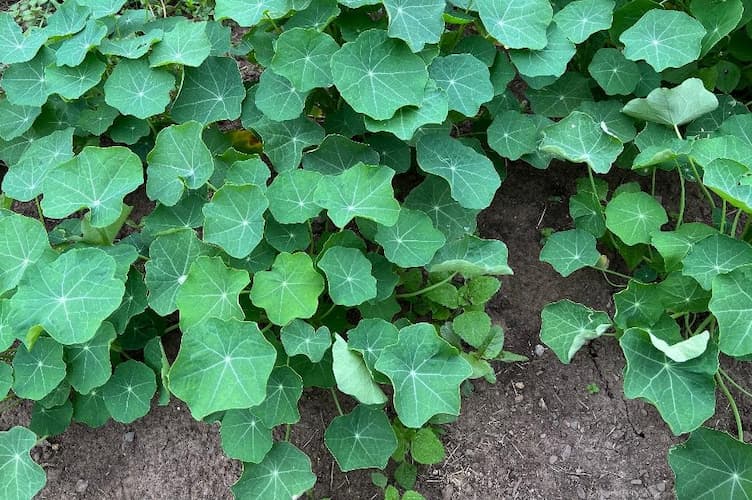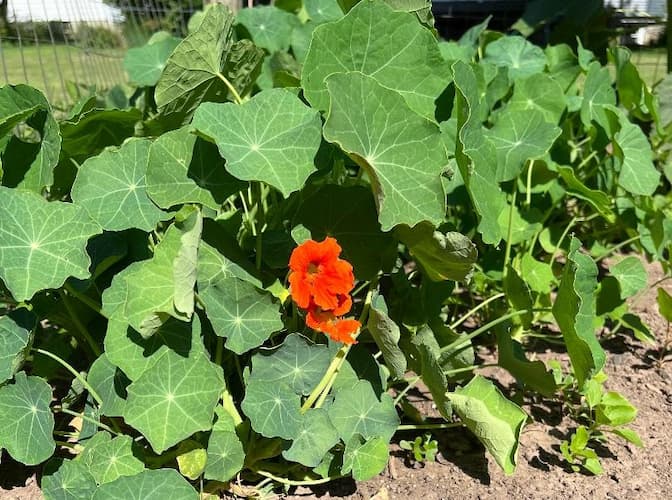How to Grow Nasturtium Flowers

About Growing Nasturtium Plants in Your Home Flower Garden
If there is a secret flower growing in the gardening world, it is Nasturtium plants. These easy-to-grow members of the Cress family offer a lot of benefits to you the gardener, and other plants in your garden. As a companion plant, it deters insect pests that may affect other crops. If you are growing Nasturtium annuals, will you do so in the flower garden or the vegetable garden? Chances are, you will plant it in the flower garden. But, you can eat the leaves, flowers, and seeds.
Here are some of the benefits you enjoy with these flowers, err vegetables, err…..
An easy and quick growing annual.
The edible leaves spice up salads
This companion plant helps to ward off insect pests.
The plants prefer to be ignored. It thrives in poor and dry soils.
Nasturtium flowers come in a variety of colors.
The flowers provide good color in the garden but are not great as cut flowers.
Nasturtium Flower Plant Specifications
Flower colors: Colors include orange, pink, red, yellow, and white.
Flower Blooms: Summer to Fall,
Plant Height: Smaller varieties: 6″ – 12″; larger varieties: up to 15″
Ideal Soil pH: 5.5 – 7.5.
Light Requirement: Full sunlight.
Hardiness Zones: 9 – 11
Are Plants Toxic? Seeds are toxic.
Deer Resistant? Yes. They are resistant to deer and rabbits.
Native To: Andes mountains of South America.
Plant Type: Annuals and perennials.
Botanical Name: Tropaeolum spp.
Other Names: Nasturtiums are also called Canary Bird Flower
Are Nasturtium Plants Edible?
YES!! Deer and rabbits shy away from the peppery taste of Nasturtium plants. However, many people include the plant in their diets.
All parts of the plant are edible, including flowers, leaves, stems, and young seed pods. Eat this plant raw or cooked. Use it in salads and any recipe that calls for greens. It adds flavor to soups, stews, and a wide variety of other recipes.
Medicinal Uses for Nasturtium Flowers
Nasturtium plants are used in a variety of medicinal applications and home remedies. Here are some of them:
- The plant is high in Vitamin C. It helps to boost the immune system.
- Use it to reduce nasal congestion and chest congestion.
- It has antioxidant properties that promotes wound healing.
- It helps to fight colds.
- Use it to treat urinary tract infections.
- It reduces coughs and bronchitis.
- In addition to medical benefits, Nasturtium stimulates hair growth.
Light Requirements
Grow Nasturtium plants in bright, direct, full sun. Select a planting location where they will receive six to eight hours of full sunlight.
The plants grow in partial sunlight. However, if they do not receive sufficient sunlight, the plant will produce fewer blooms.
In warmer regions of the country, plant them where they are shaded from the hot afternoon sun.
Varieties of Nasturtium Flowers
There are two types of Nasturtium, a regular plant that grows 6 to 10 inches and a vining type that grows to about 15 inches.
The most common varieties include:
Dwarf Jewel
Alaska
Gleam
Annual Nasturtium Plant Propagation
Annual Nasturtiums are fast-growing. They can be directly seeded into your garden. Sow seeds after the last frost date for your area. Depending upon soil temperature when planted, they will usually come up in 7 to 14 days, sometimes less.
Sow Nasturtium seeds 1/2 inch deep and 10 to 12 inches apart.
Nasturtium plants grow very well in poor soils and like dry soils. So you can plant these versatile flowers in areas where other flowers and vegetables would fare poorly.
Days to Germination: 10 – 14 days.

How to Grow Nasturtium Flower Plants
Nasturtiums are a flower and a vegetable that begs to be ignored. Grow them in poor soils and if anything, keep the soil dry. Don’t bother with mulch, compost, and fertilizers. They do like full sun but will tolerate partial shade. They make great plants for those areas in your garden that other plants refuse to grow in.
Just remember, keep the soil con the dry side, and they will grow well.
The taller varieties look good growing up a small fence or trellis. If you plan on eating the leaves, the trellis helps to keep them cleaner than plants grown along the ground.
Annual Nasturtium plants are susceptible to frosts and freezes. Protect young plants against unexpected late frosts. And, be ready to cover up the plants in the Fall. If they are still blooming as fall arrives, cover them on cold nights. If you plant them in a flower garden along your house, they just might be the last vegetable you harvest in the fall.
Saving seeds for next year’s crop? It’s easy. Just harvest the brown and dry seed pods before they crack open and spill their seeds. Yes, Nasturtium plants are good re-seeders.
How to Grow Nasturtium Flower Plants in Containers
Annual Nasturtium flowers are not a popular choice for containers or flowerpots. However, you certainly can grow them in a container on your patio, or deck.
In addition to the normal steps for growing them, here’s how to care for them in a flowerpot or container:
- It is important to have a drain hole to allow excess water to drain from the pot.
- Keep an eye on the moisture level. Check the plants every day or two, especially in extended periods of hot, dry weather.
- Keep the soil moist, but not wet. It is okay to let the top of the soil begin to dry between watering.
- When watering the plants, thoroughly wet the soil. Excess water will drain through the hole in the bottom of the flowerpot.
- Nutrients in a flowerpot are limited. So, use fertilizer spikes to feed the plants. Or, apply a light solution of liquid fertilizer once a month.
- Select a sunny to partly sunny location on your deck.
Insects and Plant Disease
Nasturtium plants attract aphids. They make a good companion plant, drawing the aphids away from your vegetable crops. Use a garden hose to spray the insect off of the plant. If you are not going to eat the plant, you can also use insecticidal soap, Sevin dust, or Neem oil to control aphids and the occasional other insect pests.
Most diseases are infrequent. However, bacterial leaf spot can occur. Guard against this problem by keeping water off of the leaves when watering and increase air flow around and through the foliage.
The plants suffer from root rot in wet soil.
Also see: Plant Problems – Identify the causes and find the cures.
Pruning Nasturtium Plants
Get out your pruning shears for this plant. Chances are that this plant will experience an insect infestation or a bout with plant disease before it succumbs to frost in the Fall.
Remove any leaves that are damaged by insects, plant disease, or the wind. Remove any broken stems, too. If the plant gets leggy, prune the stems back to promote healthy new growth.
Deadheading spent blooms is not required, either. However, you may want to remove them to improve plant appearance. If you leave them on the plant, you can harvest seeds for next year’s crop.
More on Deadheading spent blooms.
Eat Your Nasturtium!
Annual Nasturtium plants attract aphids. As a companion plant, they draw aphids away from vegetable crops. Remove them by spraying the plants with a garden hose. If you are not going to eat any of the plant, you can also use Sevin dust, or insecticidal soap, or Neem oil.
Also see: Plant Problems – Identify the causes and find the cures.
Surprise, surprise…. There’s a flower in your flowerbed that is edible. The tender young leaves, flowers, and seeds are edible. Nasturtium leaves have a peppery taste. Use them in salads, soup, and stew recipes.
The edible leaves can be harvested as soon as several leaves are on the plant. Like any leaf type of plant, they taste better when young and older leaves can be bitter. The flowers are also edible but have less taste. Try using the seeds in pickling for a somewhat different taste.
Try a Nasturtium recipe……..
Nasturtiums are Great Companion Plants
Nasturtium is an excellent companion plant. Their peppery leaves ward off insects. Among those common pests that nasturtium is believed to deter are cucumber beetles and squash vine borers.
Related Articles
Also, people who read this article will like:
How to Grow Nasturtium Plants by Garden Hobbies
Please support our site. Shop for:
- rmmatthews100@hotmail.com
- 585-721-6528
- Rochester, NY
©1999-2024 GardenersNet.Com, All Rights Reserved

